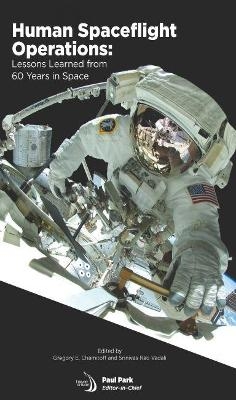
Human Spaceflight Operations
American Institute of Aeronautics & Astronautics (Verlag)
978-1-62410-399-5 (ISBN)
The purpose of Human Spaceflight Operations: Lessons Learned from 60 Years in Space is to share collective experience on human spaceflight operations. For the many authors, this is nothing less than a work of passion. They are sharing their life's work with the goal of passing on their experience to the next generation of space engineers, designers, operators, and crew.
The lessons learned are applicable to anyone working in the space industry as part of a current or future national or international space program, private space enterprise, human, or robotic mission. The book's chapters cover the primary technical disciplines related to spaceflight operations. In each case, the essential concepts and evolution of the systems and technology are discussed in some detail, but the focus is on how spaceflight operations are performed. Lessons learned are derived from incidents that occurred during actual space missions. Some of these lessons are explained directly by the astronauts who experienced them firsthand.
This is not a book on space mission design, of which there are many. The aim is to shine light on the subject of space operations, as distinct from engineering design. However, the most important lesson is perhaps that operational requirements must be considered very carefully in the design process. The subjects covered are wide ranging, but all within the scope of human space mission operations. There are many other space-related lessons learned beyond operations – political, financial, managerial, and these can be found in some of the references provided. It is the hope of the authors that through the process of explaining how things really work in Space and Mission Control, future missions can benefit from the experience (and mistakes) of so many pioneers that have come before.
Dr. Gregory E. Chamitoff is the Zachry Chair Professor of Practice in Aerospace Engineering, and Director of the AeroSpace Technology Research & Operations (ASTRO) Laboratory at Texas A&M University. His research includes space robotics, autonomous systems, and the development of collaborative VR simulation environments for space system engineering and mission design. Originally from Montreal, Canada, he served as a NASA Astronaut for 15 years, including Shuttle Missions STS-124, 126, 134 and Space Station long duration missions Expedition 17 and 18. He lived and worked in Space for almost 200 days as a Flight Engineer, Science Officer, and Mission Specialist. His last mission was on the final flight of Space Shuttle Endeavour, during which he performed two spacewalks, including the last of the Shuttle era, which also completed the assembly of the International Space Station. In Mission Control, Chamitoff served as a flight controller and later as Lead CAPCOM in support of ongoing missions. Chamitoff earned his B.S. in Electrical Engineering from Cal Poly, M.S. in Aeronautics from Caltech, and Ph.D. in Aeronautics and Astronautics from MIT. He also holds a minor and a Master's in Planetary (Space) Science. A recipient of two NASA Spaceflight Medals and the NASA Exceptional and Distinguished Service Medals, he was inducted into the California Space Authority Astronaut Hall of Fame. Dr. Chamitoff serves as the Board Chair for the Texas Space Grant Consortium and is an AIAA Associate Fellow.Dr. Srinivas Rao Vadali is Professor and Interim Head of the Department of Aerospace Engineering at Texas A&M University. He received his B.Sc. in Mechanical Engineering from National Institute of Technology, Rourkela, India, M.E. in Aeronautical Engineering from the Indian Institute of Science, and Ph.D. in Engineering Science and Mechanics from Virginia Tech, and has more than 37 years of academic teaching and research experience. He has made significant contributions in the areas of satellite attitude control and orbital mechanics. He is a co-author of the book Spacecraft Formation Flying: Dynamics, Control and Navigation. He has served as Associate Editor of the AIAA Journal of Guidance, Control, and Dynamics and the International Journal of Aerospace Engineering. He is a Fellow of the AAS and an AIAA Associate Fellow. He has received the AIAA Mechanics and Control of Flight Award and the AAS Dirk Brouwer Award, and serves as the Associate Director for the Texas Space Grant Consortium.
| Erscheinungsdatum | 11.03.2021 |
|---|---|
| Verlagsort | Reston |
| Sprache | englisch |
| Gewicht | 2058 g |
| Themenwelt | Technik ► Fahrzeugbau / Schiffbau |
| Technik ► Luft- / Raumfahrttechnik | |
| ISBN-10 | 1-62410-399-5 / 1624103995 |
| ISBN-13 | 978-1-62410-399-5 / 9781624103995 |
| Zustand | Neuware |
| Haben Sie eine Frage zum Produkt? |
aus dem Bereich


